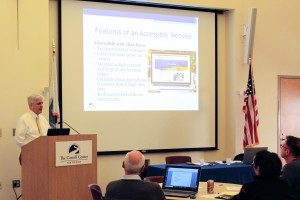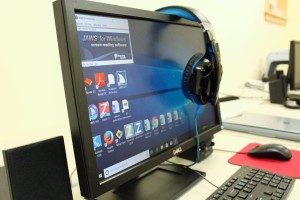What Types of Digital Accessibility Clients Does The Carroll Center for the Blind Work With?
 As Manager of Accessibility Services at The Carroll Center for the Blind, I am often asked what types of clients we work with to improve the accessibility of their digital footprint. There are a couple of different ways I can answer this question.
As Manager of Accessibility Services at The Carroll Center for the Blind, I am often asked what types of clients we work with to improve the accessibility of their digital footprint. There are a couple of different ways I can answer this question.
One way is to list all of the different industry sectors we have worked in. These have ranged from retailers operating e-commerce sites, major league sports, colleges and universities, banks and credit unions, healthcare providers, airlines, government agencies, museums, publishers, technology companies and non-profits. But a better way I can respond to the question about the types of clients we work with is to simply say that anyone who maintains a website, an enterprise web solution, or mobile applications that are intended for public access or use by employees with disabilities are viable candidates for our services. It really doesn’t matter what the business does, or what industry sector it falls within. The key issue is whether persons with disabilities are going to be able to independently access the content, and effectively navigate through it and interact with every element contained within it.
 In an age when consumers are expected to do more and more online, accessibility and usability become an increasingly critical necessity from both sides of the equation. Students, customers, clients, and members want to get information, make choices, and transact business through their phones, tablets, and computers because it’s supposed to be faster and more convenient. Site owners encourage everyone to use these devices to get information, transact business, attend classes, schedule an appointment, and register for services without the need for human interaction. It saves them money and provides access to a myriad of products, classes, and information in an efficient manner.
In an age when consumers are expected to do more and more online, accessibility and usability become an increasingly critical necessity from both sides of the equation. Students, customers, clients, and members want to get information, make choices, and transact business through their phones, tablets, and computers because it’s supposed to be faster and more convenient. Site owners encourage everyone to use these devices to get information, transact business, attend classes, schedule an appointment, and register for services without the need for human interaction. It saves them money and provides access to a myriad of products, classes, and information in an efficient manner.
So, what happens when a percentage of the public or even a single employee, is unable to participate in this digital life with the same ease as everyone else? We have created an unequal playing field for a percentage of the population, who through no fault of their own, cannot use the methods of accessing online content that their non-disabled counterparts use. This is the real reason The Carroll Center for the Blind entered into the field of digital accessibility consulting. We want to remove those barriers, enabling our clients to better serve all of their current and potential site visitors no matter their disability. The Carroll Center brings a wealth of knowledge about those consumers who rely upon a higher level of accessibility than the company, school, or organization may have initially brought to their digital footprint.
I have witnessed the joy that someone who is blind finds when they learn to use screen reading software, and can suddenly access web content in ways they had never experienced before. But, I’ve also seen the frustration these same blind consumers find when things aren’t accessible. Can you imagine, for example, selecting an item you want to purchase, including the size, color, and quantity, but then discovering that the final step of submitting your order is not keyboard accessible? You have to click your mouse, and no other means of activating that button with “keyboard only” commands will work?
It’s these types of experiences that motivated The Carroll Center for the Blind to work with companies, colleges, and other organizations. It’s why we have been steadily growing our client base and positive reputation in the digital accessibility arena, and why we will continue to teach our clients how to be a more inclusive online competitor. By addressing the issue of accessibility, you are doing good for the greater community, increasing significant market share and business opportunity while meeting regulatory and legal compliance.
Please email me at bruce.howell@carroll.org, or call me directly at 617-969-6200 x210 if you would like to speak with me about how we can help you to achieve greater accessibility and opportunity.


